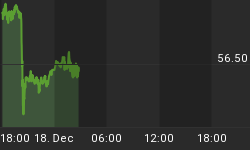"A second consecutive close above the 5-week moving average in gold bodes well for a break of this resistance level, after which $690 and $700 become strong resistance. The daily chart in silver shows the white metal clinging tenaciously to the 5-day moving average, right into last week's $12+ resistance, before Friday's rally catapulted silver cleanly through. The weekly chart... puts the first target for this encouraging move in silver near $12.40. A successful break above there could see as high as $12.60 with an eventual return to about $13, though probably not in a straight line. As of Friday, the fate of the metals looks good in the very short term and the very long term, but... the possibility that a negative event or events may yet stand between here and new highs persists.
"It should be noted the speech did not promise the Fed would necessarily be proactive in its accommodation. The new focus on the "timeliest indicators" suggests a more market sensitive approach, though, and while the nature of these chosen indicators is a matter of speculation, the daily effective funds rate, credit spreads, and yields of short term Treasuries all seem likely candidates. ~ Precious Points: Notes from the Maestro, September 1, 2007
The breakout that precious metals investors having been waiting for all year finally materialized this week, but is this rally more than just fool's gold? Can these gains be sustained? Though gold may be very short term overbought, the weekly chart in the yellow metal shows a little more room to run as price rockets upward from the 5-week moving average. The 5-week sma, which is currently below $685, has never reached above $700 during the current bull market, and this could be an interesting development to monitor in judging the longevity of this rally.

Silver also just had its best week in months, breaking through RSI trendline resistance and closing above the 50-day simple moving average for the first time since August 6. The resistance levels mentioned last week, $12.40 and $12.6o, were acknowledged by the price action over the past five trading days, but were ultimately shattered by the strength of this upward move. Though silver closed above the 50-day sma, the vibration around this level suggests it could be retested early next week, with $12.60-12.65 probably providing good support. A positive test would clear the path for $13.00, which should prove formidable.

While the early rally in the metals was clearly anticipated by a last weekend's update, Friday's breakout was a bit problematic and widely considered to be technical, based on the move above $700 in gold and the damage to the dollar after the startling low payroll data. But, more importantly, the action seems reminiscent of the now familiar pattern where metals are initially bought as money flees stocks only to be eventually sold as credit conditions deteriorate in the face of an unmoved central bank. Though the Fed is likely to offer at least some modest accommodation on or before September 18 if bank liquidity is again threatened, the contagion that inflicted metals mid-August would probably have to reemerge before any drastic action is taken.
Last week, as the media clamored about the Beige Book and the unemployment data, the opinion had been clearly articulated here that the Fed would probably pay more attention to market indicators like the overnight rate, credit spreads and Treasury yields. Despite the continued unwillingness of European banks to lend to each other, as demonstrated by the climb of the LIBOR, domestic credit market indicators mildly improved and the Fed did not intercede apart from a few term repos. Still, overnight rates have recently been closer to the target than they had been in weeks and generally the financial markets fell short of signaling the sort of acute disaster that would provoke an emergency rate cut.
So, though relatively tight TIPS spreads and weak job growth signal that the path to a cut is clear, the implications for metals, then, are less than certain. Parabolic moves in the metals are always driven by speculation, by the movement of hot money. And, as most traders know, the money can move out of metals as fast as it flows in. A return to the panic of August, or a housing-led recession beyond the Fed's ability or desire to mitigate, would have detrimental effects on metals even if they retain their current higher trading range and prove to outperform certain other asset classes. Ultimately, expansion of the money supply will continue inflating the dollar denominated price of metals, particularly if the ECB, BoE, or BoJ find themselves hiking rates by the end of the year. And a Fed rate cut may be the catalyst that drives gold to the target in the chart below, but, if you don't already know what comes next, you'll have to join to find out.
















